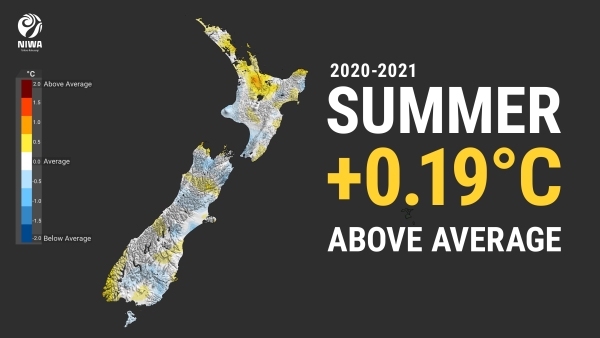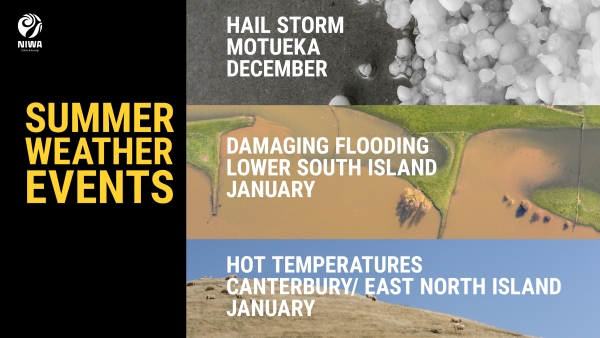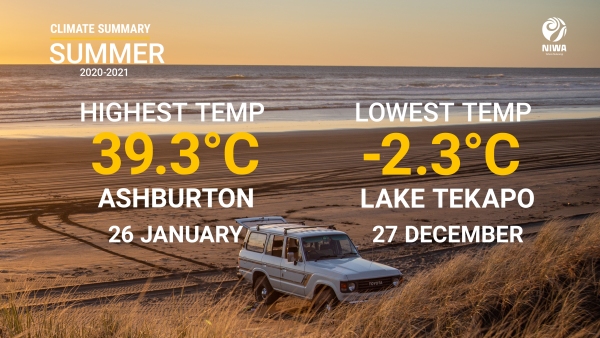Dry for much of the country, near average temperatures
|
Rainfall |
Summer rainfall was below normal (50-79% of normal) or well below normal (<50% of normal) for the majority of the North Island, and much of the northern half of the South Island. Above normal summer rainfall (120-149% of normal) was observed in eastern parts of central and north Otago. Summer rainfall was typically near normal elsewhere (80-119% of normal). |
|
Temperature |
Summer temperatures were near average (±0.50°C of average) for the majority of New Zealand. Above average temperatures (+0.51°C to +1.20°C of average) were observed in parts of northern Auckland, Waikato, Bay of Plenty, and a few isolated locations in Hawke’s Bay, Tasman, Canterbury and Otago. |
|
Soil moisture |
Below normal soil moisture levels were a prominent theme throughout the season, which reflected the lack of rainfall observed in many areas. The main exceptions were coastal parts from Taranaki to Wellington in December, parts of Otago and Southland in January, and parts of the Far North in February where soil moisture levels were temporarily above normal due to notable rainfall events. At the end of summer, soil moisture levels were below or well below normal across most of the country. |
Overview
Summer 2020-21 was characterised by lower than normal mean sea level pressure east of the North Island, with above normal pressure in the Tasman Sea. This pressure set up was associated with a slight southwest airflow anomaly for most of Aotearoa New Zealand. This airflow pattern was influenced by a non-traditional variety of La Niña in the tropical Pacific - typically, New Zealand experiences more northeasterly winds during La Niña summers.
It was a dry summer for much of the country, especially in parts of Waikato, Bay of Plenty, Hawke’s Bay, Wairarapa and Marlborough where rainfall totals were well below normal (<50% of the summer normal). Summer rainfall was typically below normal (50-79% of the summer normal) for the remainder of the North Island, although near normal rainfall was observed in parts of Taranaki, Manawatū, Kapiti Coast and Wellington. Summer rainfall was below normal or near normal (80-119% of the summer normal) in most of the South Island. The exception was eastern parts of central and north Otago, where above normal rainfall was observed (120-149% of the summer normal). This was largely as a result of heavy rainfall over several days early in January, which caused widespread flooding issues in Otago (see Highlights and extreme events section for further details). The lack of rainfall compared to normal contributed to below normal soil moisture levels for many parts of New Zealand throughout summer.
Summer temperatures were near average (-0.50°C to +0.50°C of the summer average) for the majority of New Zealand. This was reflected in the nationwide average temperature which was 16.9˚C (0.2°C warmer than the 1981-2010 summer average, using NIWA’s seven-station temperature series which begins in 1909). Exceptions to the near average temperatures occurred in parts of northern Auckland, Waikato, Bay of Plenty, and a few isolated locations in Hawke’s Bay, Tasman, Canterbury and Otago. These locations observed above average temperatures (+0.51°C to +1.20°C of the summer average). Although mean temperatures were relatively unremarkable, exceptionally hot temperatures were recorded in eastern parts of New Zealand in late-January. Ashburton recorded a maximum temperature of 39.3°C on 26 January, which is equal to New Zealand’s 11th-hottest temperature on record. On this day, 11 stations in the eastern South Island recorded maximum temperatures above 37.0°C.
Further Highlights:
- The highest temperature was 39.3˚C, observed at Ashburton on 26 January. This equalled New Zealand’s 11th-hottest temperature on record.
- The lowest temperature was -2.3˚C, observed at Lake Tekapo on 27 December.
- The highest 1-day rainfall was 132 mm, recorded at Arthur’s Pass on 19 January.
- The highest wind gust was 180 km/h, observed at Cape Turnagain on 12 December.
- Of the six main centres, Tauranga was the warmest, sunniest and driest, Wellington was the wettest and least sunny, and Dunedin was the coolest.
- Of the available, regularly reporting sunshine observation sites, the sunniest four locations in 2021 so far are Taranaki (602 hours), Marlborough (573 hours), Hawke’s Bay (564 hours) and Bay of Plenty (559 hours).
Download
- Climate Summary Summer 2020-21 [PDF 327.64 KB]




